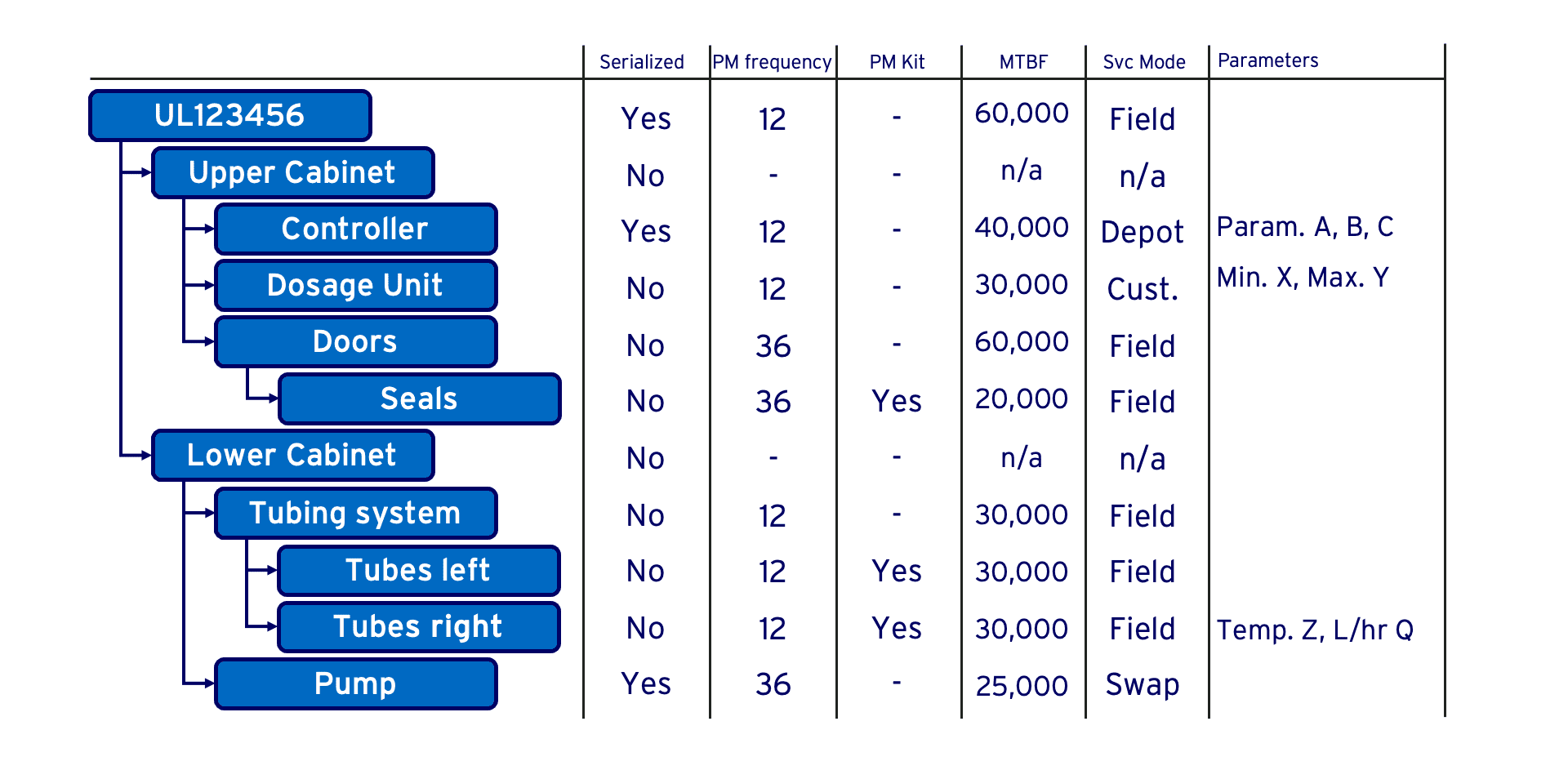When we embark on a digital transformation journey in the after-sales domain, where does the process start? With the sale of the product? Commissioning of the product? First service call? We believe the foundation for the design of your service delivery processes starts in engineering.
This blog is part 1 in a series of three.
- Part 2 – How the Service Bill of Materials Drives System of Record Platforms
- Part 3 – How the Service Bill of Materials Enables Cross-selling & Upselling
The creation of the service manual
When Engineering designs a product, they have an intended use profile in mind. That use profile defines wear-and-tear. Subsequently, the maintenance engineering function will define mitigating strategies to maintain the output specifications of the product and to sustain/prolong its lifecycle. The results are typically captured in the service manual and the Service Bill of Materials (BoM).
The golden standard of service
In a recent engagement with a prospect of ours, we asked to see the service manual of a medium-complex product to scope the service delivery business processes. Our premise: we may upsell on the service manual and promise higher value, but when we deliver less, product continuity and lifecycle may be at risk. As such, the service manual can be seen as the golden standard of service delivery.

In the 165 page pdf-document, we found a wealth of information on what to do, when to do it, and how to do it. Bill-of-materials, serviceable parts, PM-frequencies and kits, recommended consumables and spare parts, installation parameters, calibration values, and MTBF rates. We got enthusiastic. If somebody in engineering created this document, how does it ‘flow’ to after-sales? What system of record does after-sales use to be able to act upon the information in the service manual?
Digital thread
In the last decade, we’ve seen a lot of digitization initiatives driving the transformation agenda. We’ve also seen that a lot of digital data is still created and collected in silos. Engineering is digitizing product lifecycle management (PLM), manufacturing is pursuing Computer-aided manufacturing (CAD), sales are rolling out customer relationship management (CRM) and service is reshaping field service management (FSM). But how do they link to one another? Isn’t the overarching value promise of digitization the sharing of data leading to 1+1=3?
If your organization is in the business of designing, manufacturing, selling, and servicing products, then all those functions are connected through a digital thread. The carrier of the thread is the product itself. Starting as an as-engineered and subsequently transitioning into an as-built, as-sold, and as-maintained. In each stage of the lifecycle, additional information is added to the thread. Zooming out, each function will look at the digital thread through a lens to increase the value proposition.
Design for service
In our engagement with the above-mentioned prospect, we were curious how much design-for-service thought was put into the engineering phase and how that information would shape the design of the service delivery processes. Though the wealth in 165 pages of the service manual was phenomenal, the service organization had not yet invested in processes to receive the engineering baton.
The opening paragraph of the service manual provided a great narrative to introduce the baton. “Congratulations on your purchase. To protect your investment and get maximum return, we’ve defined some handles for good husbandry. This manual contains the instructions to guarantee the nominal output over its technical lifecycle”. In other words, the service manual defines the golden standard of maintenance to underpin the value promise of the product sale[1].
What Engineering documented in the 165-page service manual can be condensed in the following picture. In the first column, we find the Service-BoM. The Service-BoM is a subset of the Engineering/Manufacturing BoM. It contains only those parts that are serviceable. The manual pre-empts what skills are required to perform that serviceable activity. Can it be done by the customer, does it require a skilled technician or should the part be swapped in the field to be repaired in a depot/repair center?

With the above information from maintenance engineering, service delivery has a great blueprint defining what output its business processes should deliver. Analogously, service sales has an anchor to model cross and upsell offerings for customers having needs beyond the baseline described in the service manual.
Design for improvement
The service manual also serves another very important purpose; improvement. Improvement in two directions. Engineering giving handles to service and service giving feedback to engineering. As an illustration, I’ll use the mean time between failures (MTBF) column in the above table.
When Engineering designs a product, they typically have an idea of the lifecycle/MTBF of used components. Those values initially are theoretical numbers. Call them Plan. When the product hits the field in larger numbers, empirical values will trickle in. Call them Actual. When Actual is within a narrow margin of Plan, we say this is expected behavior. When it falls outside the margin, we call it an outlier. Understanding the root cause of the delta between Plan and Actual will enable you to drive improvement by process design.
- Maybe the product was not installed properly
- Maybe the product was not used as intended
- Maybe engineering was wrong
- Maybe service delivery was not in line with the service manual
- Maybe the customer pushed out a preventive maintenance cycle
- Maybe non-approved spares have been used
Actionable Service-BoM
What started as a trivial ask “can you share the service manual of a medium complex product” resulted in a pivotal conversation bridging engineering and service. The service manual is no longer a static 165-page pdf-document sitting in a knowledge repository. It is now an actionable document driving improvement and value in both the service and engineering domains.
[1] When selling products with a transfer-of-title, the risk of maintaining the product transfers to the buyer. Thus, the buyer becomes responsible to mitigate that risk in order to continue receiving the outcome/value of the product. The buyer may purchase maintenance services from OEM or choose differently. Read further in part 3 of this Digital Thread series.
This article is published on Field Service Digital.
